Speech The Australian Bond Market in 2011 and Beyond

Guy Debelle
Assistant Governor (Financial Markets)
KangaNews Australian DCM Summit
Sydney –
- Audio 12.48MB
Today I will discuss the current structure of the Australian bond market and talk about some trends that might influence its evolution in the coming years. I will focus on the bank debt and Kangaroo markets, given the theme of this conference. I will also address some of the issues surrounding the implementation of the forthcoming Basel liquidity standard.
Overview
To set the scene, relative to the size of the Australian economy, the Australian bond market is around the average for developed economies (Table 1). However, unlike in many countries around the world today, the private debt market is significantly larger than the public market. This reflects the prudent fiscal policy pursued by both sides of politics, at the federal and state level, over an extended period of time (Graph 1).
| Developed markets | |
|---|---|
| Japan | 38 |
| Canada | 57 |
| South Korea | 76 |
| Germany | 84 |
| Australia | 94 |
| France | 121 |
| Sweden | 129 |
| United States | 144 |
| United Kingdom | 170 |
| Netherlands | 303 |
| Emerging markets | |
| India | 8 |
| China | 21 |
| Brazil | 24 |
* Includes short-term securities not included in Graph 1 but excludes non-resident issued securities included in Graph 1. Sources: BIS; IMF; RBA |
|
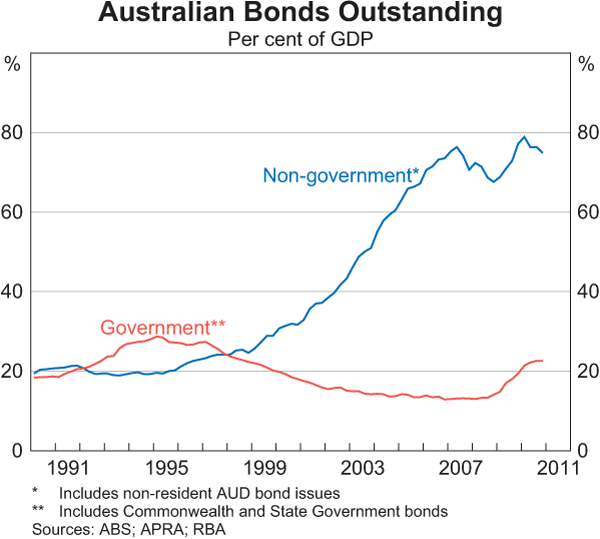
Structure of the Australian Non-government Debt Market
The non-government debt market in Australia consists of four categories of issuers: financial institutions, other corporate issuers, asset-backed issuers and non-resident Kangaroo issuers. As can be seen in Graph 2, while all four segments of the market have grown over time, the development of the market has not been uniform:
- Financial institutions have for some time had the largest share of issuance;
- asset-backed issuance grew rapidly during the early 2000s, but its growth was severely affected by the financial crisis;
- corporate issuance has grown steadily over the past two decades;
- more recently, strong demand for Australian-dollar assets has seen rapid issuance of Australian-dollar debt by non-residents.
I'd like to touch briefly on the main drivers of developments in each of these markets and talk about some of the potential factors affecting future issuance.
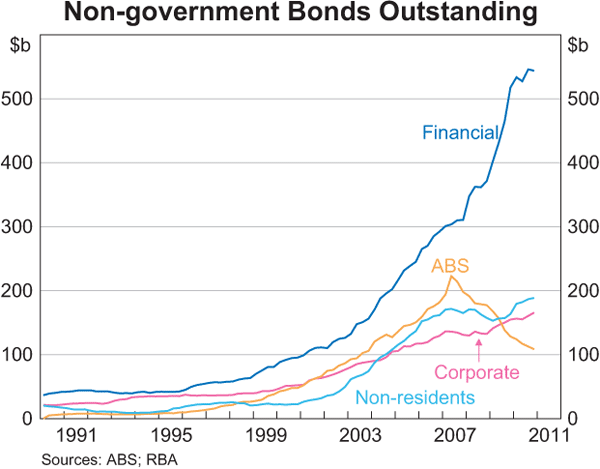
Financials
Over much of the past two decades, demand for credit outpaced the growth in deposits, so that banks accessed wholesale funding markets to support growth in lending. This outcome reflected a number of factors.
Australia's relatively high level of investment, and the sustained growth momentum of the economy over the past two decades, underpinned the demand for credit. While the source of the demand for credit shifted between household and business sectors, from the early 1990s recovery until the financial crisis, aggregate credit growth was sustained at a rate of over 10 per cent per annum.
At the same time, on the supply side, the importance of superannuation in Australia has, for much of the past few decades, constrained the growth in household deposits. Superannuation funds have historically tended to invest in wholesale bank paper rather than hold bank deposits. So, compared with other countries, more of the savings of the Australian household sector has tended to end up in wholesale bank paper rather than in deposits, with the superannuation sector as the intermediary.[1]
More recently, however, the demand for credit from households and businesses has slowed in tandem. For businesses, the reduced appetite for debt was initially due to a desire to strengthen balance sheets. More recently, strong profitability, most obviously in the mining sector, is ensuring many segments of the business sector have sufficient internal funding to meet their investment needs.
As has been discussed in much recent RBA commentary,[2] for households the slowing in demand for credit appears to be driven by a more cautious approach to debt. There are a number of factors contributing to this. One is that the increase in household leverage that occurred through the 1990s and first half of the 2000s in response to the downward shift in the nominal structure of interest rates has run its natural course. The slower growth in household wealth, and particularly the large negative shock to equity wealth at the height of the crisis, has also contributed to the cautiousness, even though equity wealth has recovered and household income growth has remained robust.
This growing caution of households in the past few years has seen the household saving rate pick up substantially, and much of this saving has been in the form of deposits, given the attractive yields on offer. The strong cash position of many businesses is also contributing to stronger deposit growth. As a result of these factors, deposit growth has outpaced credit growth for the past two years (Graph 3).
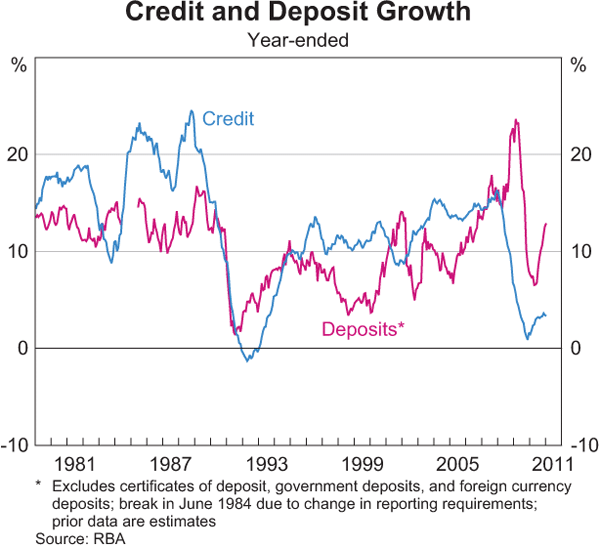
So banks have experienced a slowdown in asset growth and have funded the assets with a greater share of deposits. A consequence of this is that wholesale debt issuance by financial institutions has declined to its slowest pace since the mid 1990s. The most pronounced slowing has been in the issuance of short-term debt as banks have sought to lengthen the average maturity of their funding by increasing the share of long-term debt in total funding (Graph 4).

There are reasonable grounds to expect these trends may be sustained for some period to come. In particular, if one thinks about the composition of growth in Australia in the period ahead, it is likely to be investment-intensive. But much of that investment is likely to be funded by companies which are cash-rich or tap global capital markets directly. This means that the growth in the economy in the period ahead may be associated with less growth in business credit than has been the case in the past. It is also likely to boost deposit growth. So banks may be seeing a prolonged period of faster deposit growth but slower asset growth.
Asset-backed Securities
During the period of expansion in household balance sheets, an increasingly significant source of funding for financial institutions was the asset-backed securities market. The best example of this was residential mortgage-backed securities (RMBS) which grew rapidly as a share of the mortgage market. But as you all know, structured credit products were a major casualty of the financial crisis, even in Australia where they continued to perform very well. As a result, their share of the market has declined sharply over the past three years (Graph 5).
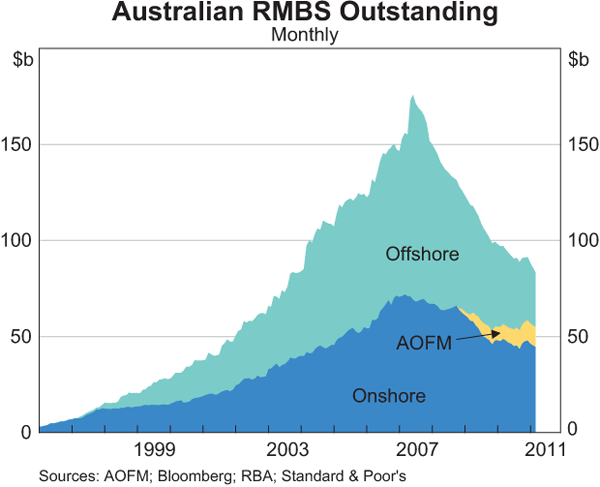
I have spoken at length recently about the specific dynamics and challenges facing the Australian securitisation market,[3] so will simply reiterate some of the key points here:
- Australian mortgage-backed securities have performed well throughout the crisis with no investor losing any money in a rated tranche;
- the fundamental quality of local collateral suggests that securitisation ought to be a viable funding mechanism in Australia;
- but securitisation will not return to the levels seen in the heady pre-crisis period, given some of the purchasers of the paper pre-crisis are no longer around.
The recent issue by one of the major banks demonstrated demand is improving for the product, at a price which was inside the recent AOFM supported deals. The Government recently announced that it will permit the issuance of covered bonds. It will be interesting to see where this product will fit with the existing RMBS. There may be different preferences between the local buyers, who are more familiar with RMBS, and offshore buyers, most obviously in Europe, who are more familiar with covered issuance.
Corporate Issuers
In many respects, the corporate segment has been the quiet achiever of the Australian debt market over the past few decades. The stock of bonds on issue from Australian entities grew solidly from the mid 1990s until the financial crisis. Although the significance of market-based funding as a share of total debt funding for Australian corporates has fluctuated somewhat, over the long run, debt market funding has grown in line with the funding needs of the corporate sector (Graph 6). As I just noted, the investment-intensive composition of growth over the next few years is likely to see continued strong corporate issuance by Australian names, particularly resources companies.

Non-resident Issuers – Kangaroos and Australian Dollar Eurobonds
The fastest growing segment of the Australian capital market over much of the past decade, and certainly in recent months, has been Australian-dollar issuance by non-residents – the market of most interest to the audience here today. Initially, much of this issuance was offshore in the Eurobond market, but increasingly issuance has moved to the onshore ‘Kangaroo’ market (Graph 7).
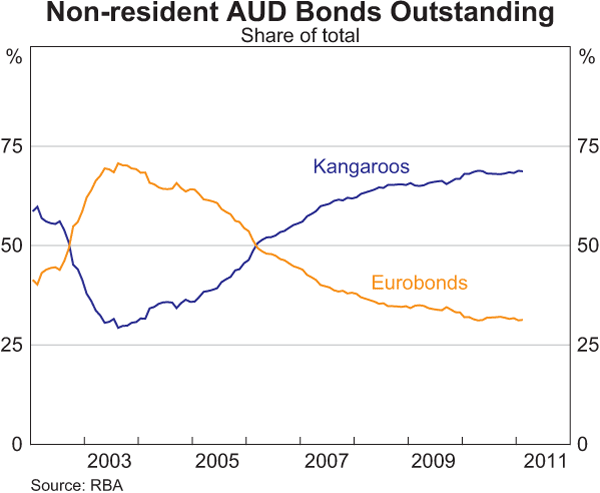
In addition to the shift in the location of market activity, an important compositional shift is occurring with new issuance increasingly dominated by AAA-rated names (Graph 8). This probably reflects the increased risk aversion of investors in the post-crisis environment.
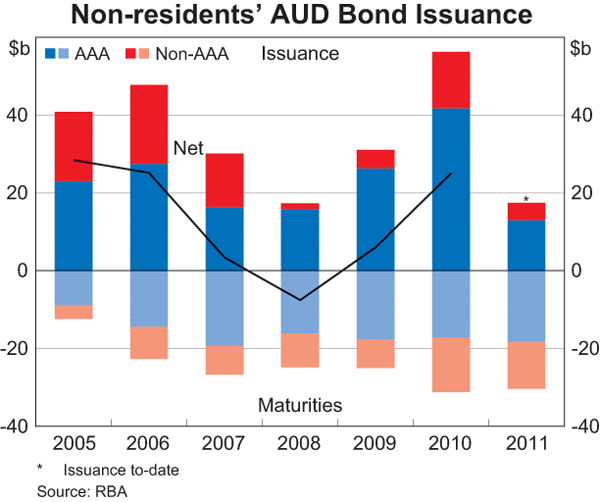
Growth in the AAA-segment of the market has been underpinned by rapid growth in issuance among the supranational and sovereign agencies (SSA) group. SSA issuance in all currencies has grown rapidly in recent years, as these borrowers have responded to the large fiscal demands stemming from the impact of the global recession on public budgets in a range of jurisdictions. In addition, SSA issuers have displayed a growing tendency to issue in Australian dollars over recent years. Last year, Australian dollar issuance accounted for more than 8 per cent of SSA issuance in all currencies (Graph 9).
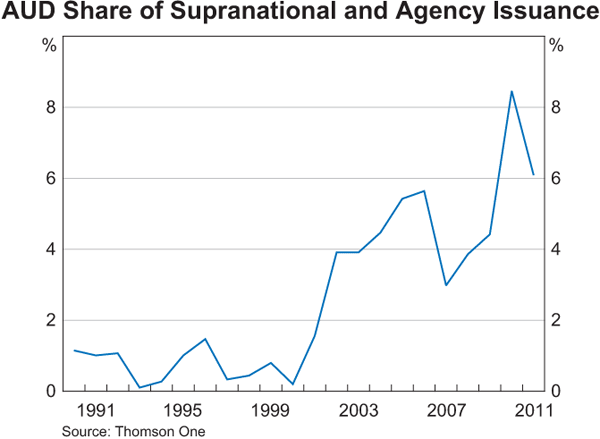
This greater tendency to issue in Australian dollars has been driven by both demand and cost considerations for issuers. On the demand side, it is clear (although hard data are not available) that global demand for high-yielding Australian-dollar assets has been growing in recent years. An emergent group of international investors, along with the domestic investor base, are interested in purchasing high-quality Australian-dollar assets, and, given the relative scarcity of Australian government paper this has created a natural opportunity for the SSA issuers.
Moreover, there has tended to be a cost advantage to issuing in Australian dollars, owing in part to the elevated cross-currency basis swap that has encouraged issuance by supras and agencies in Australian dollars. Equally as important as the cost of hedging is the large amount of foreign issuance by Australian entities that ensures access to a deep swap market for SSAs funding in Australian dollars.
APRA Liquidity Announcement
I would like to finish with a few remarks on the recent APRA announcement on eligible assets for the forthcoming Basel liquidity standards.[4] The APRA announcement stated that CGS and semis are the only assets that currently qualify as Level 1 assets and that there are currently no Level 2 assets on issue. This outcome reflected an assessment of the liquidity characteristics of the various asset classes.
As outlined in the Basel documents, key considerations in determining which assets qualify are assessments of the depth of local trading activity and the performance of assets in stressed market conditions. Specifically, the observed performance of assets during the crisis – a period indicative of a situation in which banks would need to rely on the liquidity in these instruments – was taken as evidence of proven liquidity. The statement did not rule out other assets qualifying as liquid assets at a later date, but there will need to be some history to support an assessment that a particular market has genuine liquidity.
As is widely understood, in Australia, the amount of CGS and semis on issue falls well short of the amount of liquid assets banks will need to hold to meet the liquidity standard. Moreover, it would be counterproductive to require banks to hold such a large share of these assets that it would impair the liquidity in these markets.
Hence, as announced in December,[5] the RBA will offer the banks a committed liquidity facility to meet the shortfall. The eligible assets that banks will need to hold to access this facility are those which are currently eligible for repo with the RBA in its normal operations. While a fee will be charged for this facility, I don't see that affecting the relative demand for securities, other than CGS and semis, for the following reason. One can think of the current situation as an arrangement where a flat rate of zero is charged. Banks currently hold a range of assets to satisfy their liquidity requirements, with each asset having different credit, maturity and market liquidity characteristics. Our view of how much we are willing to lend against each asset under repo are based on these characteristics, and will continue to be so.
In the future, we are moving to a world where there will be a formalised liquidity facility where a flat, positive fee is charged. So that should affect all asset classes equally and should not affect their relative attractiveness. So I would not expect this to change bank balance sheet's demand for the non-government assets they hold in their liquidity portfolios. For example, to the extent they hold SSAs today, they should still hold them in the future.
Conclusions
In my talk I have described the configuration of the bond market as it stands in early 2011. The structure of the market has changed noticeably after the events of recent years. Some of the dynamics that have emerged from the crisis may continue to shape the bond market in the future. I have highlighted three here today:
- First, the relative growth of deposits and credit may be quite different from that observed over the previous fifteen years. This, together with regulatory and other pressures, will have a material effect on the composition of bank liabilities.
- Second, while asset-backed issuance was most disrupted by the crisis, there are signs of a re-emergence.
- Third, investors have a much stronger preference for high-quality assets than they did in the pre-crisis period.
Endnotes
R Battellino (2010), ‘Financial Developments’, Address to the Property Council of Australia, Brisbane, 8 October. [1]
For more details see P Lowe (2011), ‘Some Current Issues in the Australian Economy’, Address to the Committee for Economic Development in Australia (CEDA), Sydney, 17 February and, G Stevens (2011), ‘Opening Statement to House of Representatives Standing Committee on Economics’, Canberra, 11 February. [2]
For more details see Debelle (2010), ‘The State of Play in the Securitisation Market’, Address to the Australian Securitisation Conference 2010, Sydney, 30 November. [3]
For more details on the APRA media release, see APRA clarifies implementation of global liquidity standards in Australia, 28 February 2011. [4]
For more details on the joint RBA and APRA media release, see Joint Media Release: Australian Implementation of Global Liquidity Standards, 17 December 2010. [5]